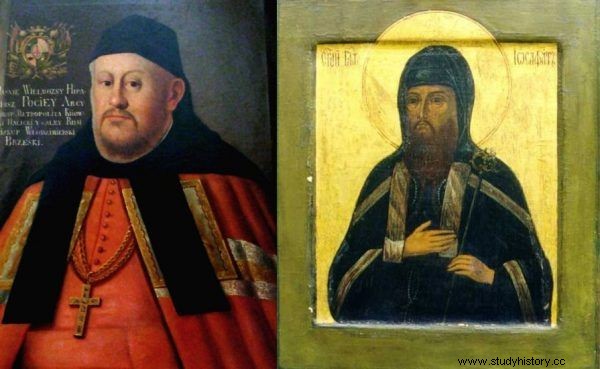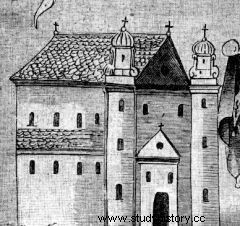Not so long ago, we all had the opportunity to see what happens when power gets under the skin of millions of Internet users. In the 17th century there was neither ACTA nor the Internet, but there were some really similar situations. Only the methods of protest were much more… vigorous.
Okay, let's find a convincing example. The so-called Union of Brest seems to be ideal - from the very beginning a miscarried project of joining the Orthodox Church in the Polish-Lithuanian Commonwealth to the Catholic Church. Behind the project were the hierarchs of the church (who were promised privileges and generous remuneration) as well as Polish church and state authorities. Its main advocate was, in turn, the monarch of Poland himself - Sigismund III Vasa.
Everything was very similar to ACTA. First, the authorities made sure that a decision that would affect the daily lives of millions of people was made without their participation, without any discussion, and preferably completely secretly . Although it was initially assumed that a special council would be organized with the participation of the rank and file of the Orthodox clergy and nobility, this idea was quickly abandoned. The decision was made by King Zygmunt:hearing that opposition to the project was growing, he ordered all discussions to be stopped and the implementation accelerated.
The hierarchs of the Kiev church - Cyril Terlecki and Hipacy Pociej - left for Rome, who on December 23, 1595 took part in a special ceremony admitting the Kiev metropolis to the connection with the Roman Church . Only after returning, the already closed case was presented to the clergy and the faithful, pretending that anything else could be discussed .

Hipacy Pociej and Józefat Kuncewicz. He miraculously survived the first, but lost his fingers. The second one died (see:picture above), but at least became a martyr ... (portrait of Kuncewicz - public domain, portrait of Pociej, photo:Maciej Szczepańczyk, license CC BY 3.0).
The situation that took place at that time was well captured by Natalia Jakowenko, author of the book "The History of Ukraine Until 1975": In this way, Russia was divided into two unequal parts. On one side stood the entire Orthodox community deprived of hierarchs, and on the other side there were Ruthenian hierarchs-Uniates without believers.
Surprisingly, the authorities did not fully predict the scale of social opposition. An anonymous author wrote: The greatest surprise was that the secular lords and the common people had a holy zeal and with all their strength opposed the plans.
The people are fighting for theirs
Then the events unfolded in a way that ... we well remember from the beginning of 2012. People - nobility, clergy, bourgeoisie, but also ordinary peasants - decided to show what they really think about the church union above their heads. What distinguished the situation then from the "discussion" on ACTA? Well, the seventeenth-century progenitors of Anonymous did not intend to limit themselves to collecting signatures and manifestations .

Saint Nicholas Church in Brest. Formally, this is where the "Brest Union" was concluded, from which little good came out ...
The lightest means of action was propaganda. First of all, unheard-of stories about Uniate bishops were disseminated among the faithful. It was said about Hipacy Pociej that he secretly converted to Judaism and was circumcised. Bishop Terlecki was hit even worse after his death in 1607. Soon rumors started to circulate that he had been strangled by the devil himself and hidden his body in an empty wooden vessel. After some time, the hierarch's own servants were to throw his corpse into the mud and this is how the crows gouged out his eyes. Besides, not only the most important enemies were attacked, but also every supporter of compromise. A certain Melecjusz Smotrycki was considered a shameful traitor only because he hinted something in 1628 about the possibility of getting along with the papists.
What a war of words! The opponents of the union also fought quite realistically. Hipacy Pociej miraculously escaped death after an attack on him was organized by three unrepentant Orthodox believers. The hierarchy lucky managed to hide himself from being hit with a stick, and the saber, sliding on it, cut off the metropolitan's fingers and cut her clothes open.

Antoni Hrekowicz was less fortunate, whom Pociej sent to Kiev to take over one of the important churches. First, Cossack hetman Hryhorij Tyskiniewicz warned that if only an unwelcome guest comes to town, they will kill him like a dog . Hrekowicz apparently did not take the threat seriously ... and he should have. A few years passed, but in 1618 death finally met the wayward governor. A squad of Cossacks drowned him in the Dnieper . The townspeople then joked that Hrekowicz was simply led under the ice to drink some water.
A similar fate befell the Union Archbishop of Płock, Józefat Kuncewicz, in November 1623. When he did not heed the warnings that he needlessly ignites dangerous sparks was killed and his body was thrown into the river .
These are just some examples of resolute actions. In general, the blood of the representatives of the authorities - both the secular and the clergy - was flowing in streams. Did this protest bring the expected results? ? Yes and no. The king quickly softened and retired largely from the union, but changed his mind as soon as the storm calmed down a bit. The Orthodox had to return to the arguments of force on an even larger scale. Only this helped and finally two church hierarchies in Ruthenia were created:the Orthodox and the Uniate.
Sources:
- Natalia Jakowenko, History of Ukraine until 1795 , Polish Scientific Publishers PWN, 2011.
